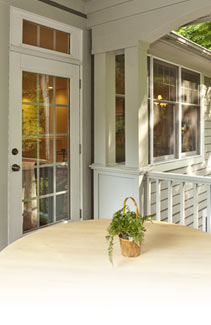Understanding Condensation
Causes
Condensation on windows and other cool surfaces in the home can be both annoying and possibly injurious to your home. Because the most often visible condensation is seen on windows, it is easy to blame condensation as being a window fault. This is not true in most cases. Any cool surface will cause excess humidity to condense on it. If there is condensation on windows, you may be assured there is condensation on walls. This is more serious since that can penetrate the walls and cause internal problems.
The cause of condensation is air saturated with too much humidity or water. When this happens, air cannot hold the excess humidity. It gets rid of it by condensing it on the most convenient cool surface.
Where does humidity come from?
- Normal breathing and perspiration by a family of four adds a half pint of water to the air each hour.
- Cooking can add up to four or five pints of water per day.
- A shower can add another half pint.
- Dishwashers, washing machines and dryers can add several pints of water to the air.
- Humidifiers which are adding too much humidity.
- Poorly insulated crawl spaces which allow humidity to invade the home.
- New homes will often emit excess humidity for the normal drying out of the building products. This is normal and will usually adjust itself within a year or less.
In other words, if condensation is to be reduced, the source and amount of humidity in the air needs to be determined.
How much humidity is too much and how much can air hold?
Warmer air holds more moisture than cool or cold air. This is illustrated on a humid, hot summer day when condensation appeared on a cold glass. This means that the amount of moisture in the air has reached its maximum and can’t hold anymore. Therefore, it gets rid of it by condensing it on the nearest cool or cold surface.
As air cools, it can’t hold as much moisture and therefore, condensation will appear more quickly.
So what is the ideal amount of relative humidity in the air? Based on keeping an indoor temperature of 70º F, it will vary with the outdoor temperature. But as a guide, the following relationship should help.
| Outside Air Temp | Inside Relative Humidity |
|---|---|
| -20° F or cooler | 15% Max |
| -20° | 20% Max |
| -10° | 25% Max |
| 0° | 30% Max |
| 10° | 35% Max |
| 20° | 40% Max |
If your relative humidity is above these levels, you probably will have condensation on any cool surface.
Is condensation more prevalent today than it used to be?
In some cases this may be true. In older houses, the insulation and weather-stripping and other house tightening factors allowed the house to breathe and exchange drier air with inside more humid air.
Of course, windows also were not so air tight and caused colder air to enter the house and can also cause the surface of the window to be colder.
Today, because we are all energy conscious, houses and windows are far more energy efficient. This makes us all more comfortable, but may trap humid air inside the home.
So, what do you do now?
The obvious answer is to reduce the humidity and decrease the number of cool surfaces in your home.
Your first step is to find what the humidity level in your home is. This will need to be monitored regularly as the temperature outside varies. Devices which measure humidity are called hygrometers. They can be purchased at most reliable hardware and home center stores.
Here are a few things you can do to control humidity:
- Make sure your humidifier is working correctly. Turn it down as the weather becomes colder.
- Vent all appliances and vents to the outside.
- Vent attic and crawl spaces.
- Cover the earth in your crawl space with a vapor barrier.
- Run exhaust fans while cooking or bathing.
- If you have a forced air furnace, make sure your home is properly ventilated by installing a fresh intake.
- Don’t store firewood inside.
- As a temporary solution, you may want to try opening your windows a little each day to allow the exchange of colder, drier air with warmer more humid air. This should not effect your energy bill in any substantial manner.
- Install energy-efficient windows.
What is an energy-efficient window and why will it help?
Windows, door and skylights have become an important part of the energy saving plan. They do not allow cold air to enter around a window, thus cooling the surface. Spacers between glazing in double or triple-glazed windows are more energy efficient and do not allow cold air to migrate through them causing the glazing to cool.
Special metallic coating have been developed (known as Low E or low emissivity) which reflects radiant heat and restricts its flow through glass. During cold weather, it will keep heat inside. In hot weather, it keeps heat outside.
Using energy-efficient windows will keep the interior glass surfaces warmer and thus reduce the interior cool surfaces on which moisture can condense.
Summary
In order to reduce condensation:
- Reduce the amount of moisture in the air as the outside temperature gets colder.
- Make sure your home is properly ventilated.
- Use exhaust fans.
- Use vapor barriers on the earth in your crawl space.
- Use a hygrometer to measure and regulate your humidity level.
- Use energy-efficient windows.
Remember, there is always a possibility that in very cold, unusual circumstances, you may still have some temporary condensation. But if the humidity level is proper and the home correctly vented, this will be short lived.
